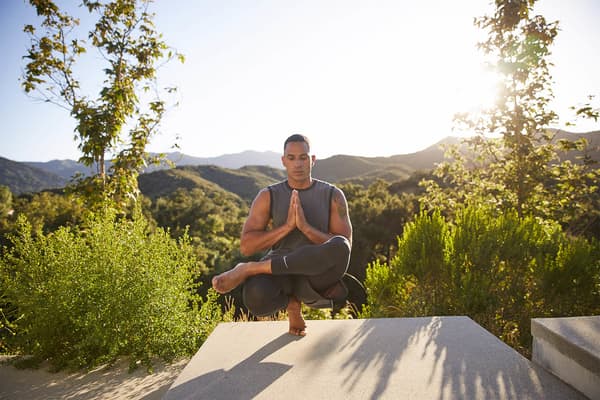4 Benefits of Aerial Yoga, According to Certified Yoga Instructors
Sport & Activity
This workout will get your blood pumping and help you access a range of yoga postures.

While aerial yoga might be storming social media these days, the practice has ancient roots. And for good reason: it touts benefits like boosting cardiovascular health and improving balance, among others.
"Aerial yoga is a full-body movement using a special fabric called a hammock", explained Mariam Michael, RYT 200, certified yoga instructor. Using the hammock, traditional yoga poses—including inversions—can be performed in the air. The use of the hammock also encourages the exploration of certain poses, as it can support some of your body weight, enabling a deeper stretch than what might be possible on your yoga mat.
And, by experimenting with aerial yoga, you'll join the legions of others who have participated in the ancient practice throughout generations. "Yoga has a lineage of having your asanas [yoga postures] be assisted by props and even by hanging", explained Michelle Dortignac, E-RYT 500, certified yoga instructor.
Nowadays, aerial yoga classes sometimes blend elements of "fitness, dance, acrobatics and Pilates", she added. Depending on your studio and instructor, Dortignac said a class may focus on one of these elements or combine them all.
Whether you're trying aerial yoga to deepen your yoga practice or mix things up, check out the top benefits of the workout.
4 Benefits of Aerial Yoga
1.Practising Inversions
As the hammock can carry some—or all—of your body weight, aerial yoga offers an accessible entry point to inversions, poses where your head is below your heart.
Getting upside down "improves circulation, gets you moving and helps you have some fun", explained Dortignac. In fact, 2018 research in the International Journal of Physiology stated that inverted postures in yoga aid "effective blood circulation to the brain".
Even if you're a beginner, you can get upside down in an aerial yoga practice. However, Ben Scheu, ATC, MS in sports medicine, stressed that these postures may be risky for "anyone with circulatory conditions, lymphatic return problems, vertigo or similar conditions".
(Related: The 7 Best Beginner-friendly Yoga Poses, According to Yoga Instructors)
Additionally, 2020 research from the University of North Georgia found that patients with cardiopulmonary diseases, like hypertension or coronary artery disease, can have a range of physiological responses to inversions, including changes in blood pressure and oxygen consumption. The researchers concluded that some forms of inversion may be beneficial to heart-failure patients, but further research is needed.
If you have questions about whether inversions—or any of the moves in aerial yoga—are right for you, consult a doctor or other relevant, licensed medical professional before you attempt the practice. You can always skip the inversions in an aerial yoga practice and focus on standard poses with hammock assistance.
2.Improving Cardiovascular Health
A small 2016 study of active women between the ages of 18 and 45, led by the American Council on Exercise (ACE), found that a six-week aerial yoga programme contributed to several cardiovascular benefits, including improvements in cardiometabolic risk factors like blood pressure, HDL cholesterol and VO2max among the participants.
The study concluded that aerial yoga has similar benefits to other moderate-intensity forms of exercise, like water aerobics and tennis. It also found that "regular participation in aerial yoga improves cardiorespiratory fitness and positively modifies several major cardiovascular disease risk factors".
Additionally, a 2014 study in the Journal of Clinical and Diagnostic Research reported findings of the efficacy of yoga on patients with heart failure. Participants were broken into two groups: one set engaged in a mat yoga practice that emphasised traditional poses and breathing exercises; the control set did not join the yoga practice.
The results found that a 12-week yoga programme "reduces blood pressure and load on the heart, and improves the parasympathetic activity in heart-failure patients". The parasympathetic nervous system helps the body relax by controlling functions such as resting heart rate and bronchi constriction to slow breathing rate.
While the study did not incorporate aerial yoga in the experiment, the fundamentals of the practice that were found to correlate to positive benefits are also included in aerial varieties, though more specific research is needed.
If you have cardiovascular or circulatory conditions, consult a medical professional for expert advice.
(Related: The Top 4 Yoga Poses to Relax, According to Experts)
3.Building Core Strength
Aerial yoga can be an effective core workout, because "manoeuvring around the hammock requires core and arm strength", explained Dortignac. When you're performing more acrobatic movement, your body weight is lifted to get established in the hammock.
"If you're hanging upside down and you have to sit up, you can't push off the floor for momentum", she said. Instead, you have to engage your abdominal muscles, essentially performing a sit-up when you're getting in and out of inversions.
Even if you're not doing the most complex poses, you're likely to strengthen your core as you stabilise your body in the air, explained Dortignac. As you flow through postures, "your core kicks in to perform the movement and keep your spine more stable". Often, your instructor will give cues to ensure you stay aware of your core engagement.
Research in a 2009 issue of the Journal of Bodywork and Movement Therapies, which evaluated grounded yoga techniques as a means of core-stability training, emphasised that core strength helps control the power in the trunk of the body, allowing for smoother, more efficient and better coordinated movement in the limbs. The article also stated that well-conditioned core muscles help reduce risk of injury due to bad posture.
Additionally, in some aerial yoga poses, your upper body rotates while maintaining trunk stability—a form of rotational core training. In others, the rotation is resisted. This is also a form of anti-rotational core training, in which your abdominal muscles are braced against a load to maintain a neutral spine and resist movement.
Anti-rotational training can be beneficial for daily tasks because "the core, more often than not, functions to prevent motion rather than initiating it", Stuart McGill, PhD, stated in a 2010 study in the Strength and Conditioning Journal. The ACE also emphasised that anti-rotational exercises help "develop a stable base for a variety of movement patterns, including rotation".
4.Deepening Poses
Aerial yoga can be helpful in improving flexibility. When you use the hammock to support traditional yoga asanas, like Forward Fold, you'll have the opportunity to deepen into poses, because your body is "doing less work [than it does on the ground], which means you can stay in the position longer", explained Dortignac.
As you settle in and hold a pose, you're statically stretching a particular muscle group, meaning those muscles are stretched without moving. Static stretching can be an effective way to increase flexibility: a 2016 review in Physiotherapy Theory and Practice found that static stretching was effective in increasing hamstring flexibility among young adults.
Some people may find that stretching with the hammock feels easier than traditional stretching, because the hammock supports some of your body weight. This takes pressure off the joints, so you can work to access certain postures, such as Triangle Pose, with less strain on the body, Michael explained.
Words by Hannah Singleton


















